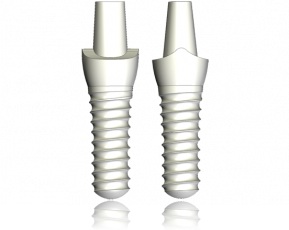If you need dental implants to replace your missing teeth and for whatever reason do not want ‘metal’, you may be considering ‘ceramic’ dental implants as an alternative. Ceramic dental implants, specifically known as zirconium or zirconia dental implants, are one of the newer forms of dental implants in the market as an alternative to titanium dental implants.
What are zirconia ceramic dental implants?
Zirconia was discovered in 1789 by the German chemist M. H. Klaproth but rediscovered only in the last decades because of its unique properties. Zirconia is a very hard material and has great strength. Because of its high bio-compatibility, it is used in medicine (auditory, finger and hip prostheses) and dentistry (posts, crown and bridge restorations, implants, implant abutments). Zirconia has similar color to teeth and is bio-compatible making it an alternative material in dentistry. Zirconia dental implants were approved by FDA in 2007 and have very limited scientific studies in United States. They have been used mostly in Europe with short term studies.
Reported advantages of ceramic implants:
- Used over 20 years in medicine, mainly for prosthetic joints, with good success.
- Bio-compatible (completely tissue-friendly); there are no allergic reactions, no sensitivity to temperature and no impact on taste.
- Gum tissue-friendly material with low plaque retention and inflammation.
- Since zirconium is white and more similar to the color of natural teeth, it may have aesthetic advantages over titanium. In rare event of gum tissue recession or shrinkage, ceramic dental implants will not reveal gray lines like in the case of titanium implants. However, it should be pointed out that similar remarkable aesthetic results can be achieved with titanium implants if they are used along with ceramic abutments and crowns.
Risks with Ziconia ‘ceramic’ implants?
- Zirconium dental implants are one-piece structures and can only work in one position, unlike a two-piece titanium dental implants that offer more flexibility in their angle through use of custom abutments. Therefore ceramic implants must be placed with extreme caution and attention to orientation and angle.
- There are reported non-integration and fractures and there are no long term studies to support their efficacy and longevity in the literature. The existing research is limited and very short term.
- Zirconia implants may be subjected to hydrolysis (a physiological process) whereby they can absorb water and potentially become more prone to fracture. Although the initial studies are favorable, more investigations are in progress.
Ceramic vs titanium dental implants?
The decision to use ceramic or titanium dental implants should be fully discussed between patient and surgeon. On one hand, many patients may request ceramic dental implants because of its ‘metal-free’ properties. As we discussed, Zirconium implants are technically a metal. On the other hand, the surgeon must follow evidence-based dentistry to make proper recommendations for long term success and safety. The following facts should be considered in the decision process:
- Titanium is regarded as the ‘gold standard’ for dental implant materials. Numerous studies have affirmed the high success and survival rates of titanium implants providing 98% + success rate. Zarconia ceramic dental implants have only about 5 years of research and limited reports in the literature. Although they show favorable preliminary results, their long term success is unknown.
- Titanium implants demonstrate high degree of integration with the bone and have excellent long term prognosis and success. The long term integration properties of zarconia remains unknown.
- Some suggest that zirconia implants have aesthetic advantage over titanium implants. However, when replacing teeth in the smile zone, most clinicians use zirconium abutments and crowns in conjunction with titanium implants, providing great aesthetic outcomes. If the gum tissue is very thin, then titanium’s gray shadow may become more visible. This potential aesthetic complication can often be avoided by proper implant site tissue development, proper placement of implant, and choice of ceramic abutments and crowns.
- Zarconia implants may not be possible to use in every patient, whether it is because of position, bone quality and quantity, and functional qualities.
If you like to learn more about ceramic dental abutments and see if it is for you, please let us know.

